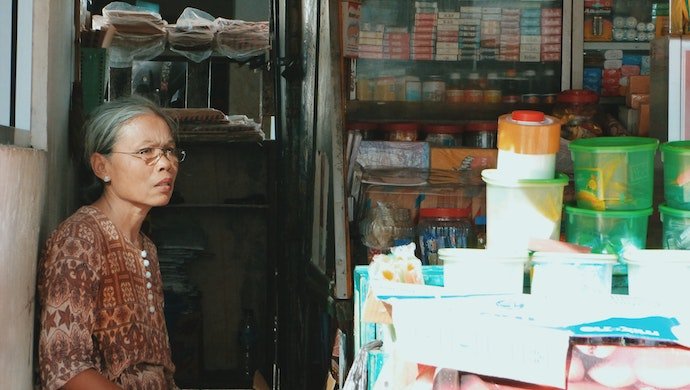
At 17, Bu Nanik started selling staples at a rented shop in Surabaya where she would travel long distances to source her inventory, and then lug the purchased goods back in a rented car. The arduous journey was expensive and time-consuming, and often entailed shutting her store during peak hours.
All that changed in 2020 when she started working with Ula. Now, with the help of our app, she’s able to get better pricing, and has products delivered to her doorstep, leaving her more time to focus on running and expanding the business. Today, Bu Nanik has five stores to her name.
While Nanik’s example demonstrates the transformative power of technology, it’s also a stark reminder that large segments of Southeast Asia’s population have limited or no access to this type of disruption.
In fact, one study estimates that 31 per cent of adults in the region are digitally excluded due to factors such as age, poor literacy, inequality and concentration of economic activity in urban areas. If this gap is left unaddressed, swathes of people will miss out on economic opportunities and the ability to improve their lives.
To build digitally-innovative solutions to bridge this gap, I believe there are three key areas to look at: Having a customer centric approach, creating user-friendly experiences and making the solutions simple. This eventually empowers people to leading better lives.
Customer centric approach
To start building any solution, we need to go back to basics. What do our customers actually want? What are their pain points? What can we do to bring value?
If customers are not familiar with online shopping, we need to find ways to engage them and get them excited to try out new services and apps.
We’ve found that doing this through gamification, leveraging simple features and demonstrating the technology’s use case is crucial to increase uptake amongst reluctant retailers. In other words, it is about perfectly balancing a powerful platform with thoughtful planning.
User-friendly experiences encourage adoption
In developed markets, technology is built for hyper-connected users who own multiple (and mostly high-end) devices. Contrary to that, technology in most emerging markets fundamentally skipped the era of home desktops and laptops, and dove straight into a mobile-first world, leading to a very different understanding and expectation of technology.
The key to penetrating this market is to create technology that’s simple, with a clear and direct value proposition. Focusing on utility and solutions instead of fancy fonts and UI transitions eliminates confusion and enables adoption among nascent digital segments.
Create simple solutions for a bigger impact
Even as digitalisation empowers the developed world, fear of change and a lack of understanding still deters traditional segments such as Indonesia’s warungs from catching up. The key to penetrate these markets is to create simple and approachable solutions that add real value to the end users.
Additionally, mobile internet connectivity is still underdeveloped in remote regions where digital solutions can deliver the most impact. People belonging to this segment often use low-end phones and pay-per-use data plans.
Therefore, apps designed for this audience must be compact to minimise mobile plan costs, be downloadable in areas with poor connectivity, and lightweight enough to avoid taking up lots of storage on their phones.
For instance, the Ula app is packaged at 4.28MB as compared to our peers’ apps which are usually around 13.4MB, enabling retailers to easily kickstart their digitalisation journey.
Empower people to lead better lives
Ultimately, the aim of technology is to make things easy by enabling better outcomes for people and businesses. This means different things for different people, but broadly should aim to increase output, decrease time spent on tasks, or provide cheaper, faster and easier access to resources.
At Ula, we see technology as a way to give valuable time back to people. In Bu Nanik’s case, it was about redirecting time spent at the pasar towards keeping her store open for longer, spending more time with her family and even upskilling herself.
Also Read: How BukuWarung is changing the back alleys of Indonesia
We would like to see this replicated across all our customers, as we believe it will have a knock on effect on the education of a future generation of Indonesians. The more money these stores earn, the longer they can keep their children at school, therefore creating a generation of knowledge workers who will have a broader range of choices than their parents had.
Digital adoption is accelerating across the region, and businesses like us play a key role in creating ecosystems that support and enable underserved segments to ensure that they’re not losing out on the benefits of technology.
The promise of technology in emerging markets is apparent. But in order to be effective, we need to ensure that it remains simple, easy-to-use and enables better outcomes for the underserved. Only then will we be able to build an inclusive digital future that is truly prosperous for all.
–
Editor’s note: e27 aims to foster thought leadership by publishing contributions from the community. This season we are seeking op-eds, analysis and articles on food tech and sustainability. Share your opinion and earn a byline by submitting a post.
Join our e27 Telegram group, FB community or like the e27 Facebook page
Image credit: Rendy Novantino on Unsplash
The post Tech for good: How Ula aims to facilitate the needs of small businesses in emerging market appeared first on e27.

